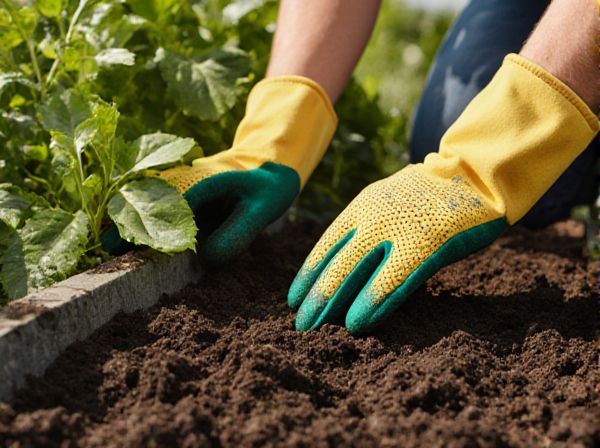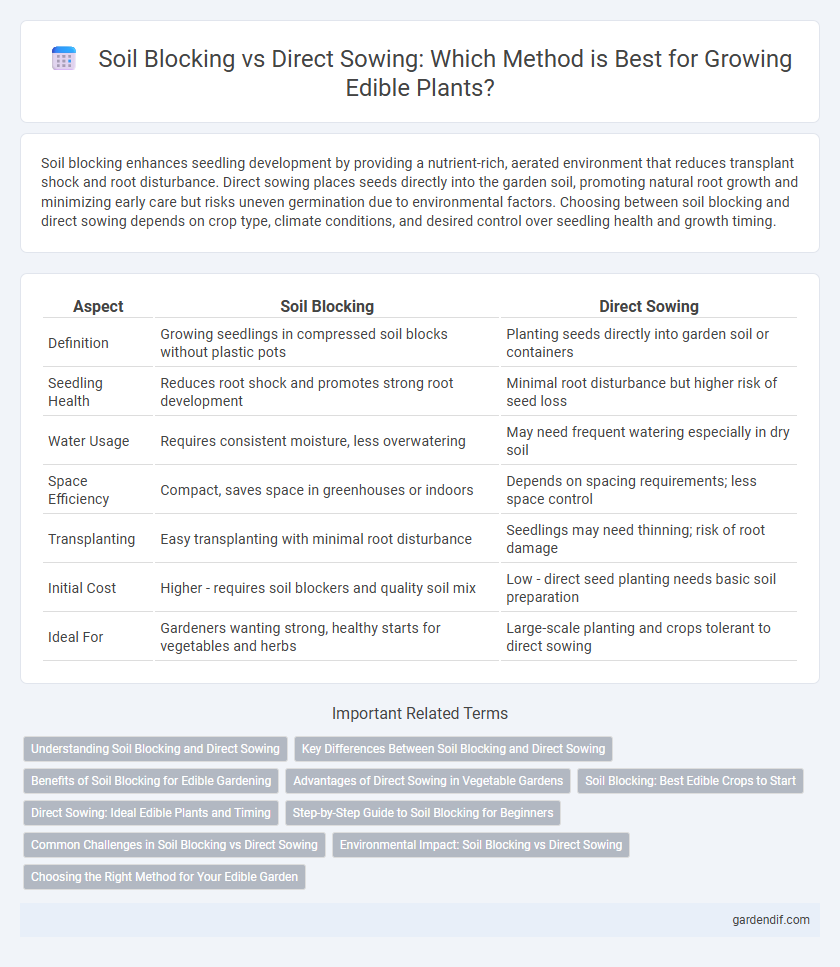
Soil Blocking vs Direct Sowing Illustration
Soil blocking enhances seedling development by providing a nutrient-rich, aerated environment that reduces transplant shock and root disturbance. Direct sowing places seeds directly into the garden soil, promoting natural root growth and minimizing early care but risks uneven germination due to environmental factors. Choosing between soil blocking and direct sowing depends on crop type, climate conditions, and desired control over seedling health and growth timing.
Table of Comparison
| Aspect | Soil Blocking | Direct Sowing |
|---|---|---|
| Definition | Growing seedlings in compressed soil blocks without plastic pots | Planting seeds directly into garden soil or containers |
| Seedling Health | Reduces root shock and promotes strong root development | Minimal root disturbance but higher risk of seed loss |
| Water Usage | Requires consistent moisture, less overwatering | May need frequent watering especially in dry soil |
| Space Efficiency | Compact, saves space in greenhouses or indoors | Depends on spacing requirements; less space control |
| Transplanting | Easy transplanting with minimal root disturbance | Seedlings may need thinning; risk of root damage |
| Initial Cost | Higher - requires soil blockers and quality soil mix | Low - direct seed planting needs basic soil preparation |
| Ideal For | Gardeners wanting strong, healthy starts for vegetables and herbs | Large-scale planting and crops tolerant to direct sowing |
Understanding Soil Blocking and Direct Sowing
Soil blocking involves pressing a moist growing medium into a block shape to create compact, air-pruned seedling cells, promoting strong root development and reducing transplant shock. Direct sowing plants seeds directly into the garden soil, offering a natural growing environment but with higher risk of seed loss due to pests or weather. Understanding the benefits and limitations of both methods helps gardeners optimize seedling survival and growth for various edible crops.
Key Differences Between Soil Blocking and Direct Sowing
Soil blocking involves shaping and compressing soil into small, reusable blocks that create a compact growing environment, promoting strong root development and reducing transplant shock. Direct sowing places seeds directly into the garden soil, which reduces transplant labor but can lead to variable germination rates and less control over early seedling conditions. Soil blocks improve aeration and drainage for seedlings, while direct sowing is better suited for plants that tolerate early soil disturbances or faster growth cycles.
Benefits of Soil Blocking for Edible Gardening
Soil blocking enhances root aeration and prevents root circling, resulting in stronger, healthier seedlings for edible gardening. By minimizing transplant shock, soil blocks improve establishment rates and promote vigorous growth of vegetables and herbs. This method reduces plastic waste, offering an environmentally sustainable alternative to traditional seed trays.
Advantages of Direct Sowing in Vegetable Gardens
Direct sowing in vegetable gardens promotes stronger root development by allowing seeds to establish directly in their natural soil environment, reducing transplant shock. This method supports faster germination and growth as seedlings access native nutrients and beneficial microbes immediately. Direct sowing also saves time and labor by eliminating the need for seedling trays or soil blocks, making it a cost-effective approach for large-scale or home gardening.
Soil Blocking: Best Edible Crops to Start
Soil blocking offers optimal conditions for starting edible crops such as tomatoes, peppers, and lettuces, promoting strong root development and reducing transplant shock. This method enhances air circulation and drainage, which helps prevent soil-borne diseases typically seen in traditional seedling trays. Seedlings grown in soil blocks tend to establish more vigorous plants, particularly for herbs like basil and cilantro, ensuring a healthier start for your vegetable garden.
Direct Sowing: Ideal Edible Plants and Timing
Direct sowing suits root vegetables like carrots, radishes, and beets, as well as leafy greens such as spinach and lettuce, which thrive without transplant shock. Optimal timing varies by plant; cool-season crops benefit from early spring or late summer sowing, while warm-season crops like beans and corn require soil temperatures above 60degF for successful germination. This method reduces transplant stress and encourages robust root development, enhancing overall edible plant yield.
Step-by-Step Guide to Soil Blocking for Beginners
Soil blocking involves pressing moist soil into compact blocks that support seed germination without plastic containers, improving aeration and root development. Begin by preparing a high-quality, well-draining soil mix, then use a soil blocker tool to form uniform blocks, pressing firmly to ensure solidity. Place seeds on top of each block, cover lightly as needed, maintain consistent moisture, and provide adequate light to encourage healthy seedling growth.
Common Challenges in Soil Blocking vs Direct Sowing
Soil blocking often faces challenges such as moisture retention issues and delicate root handling, which can lead to transplant shock, while direct sowing struggles with seed predation, uneven germination, and soil erosion. Both methods require precise environmental control; soil blocking demands consistent moisture and temperature to prevent drying out, whereas direct sowing necessitates proper soil preparation to ensure seed-to-soil contact and protection. Understanding these common challenges helps optimize growing conditions for edible plants, improving yield and reducing crop loss.
Environmental Impact: Soil Blocking vs Direct Sowing
Soil blocking reduces plastic waste by eliminating the need for disposable seed trays, promoting sustainable seed starting practices. It enhances root health through better aeration and moisture retention, leading to stronger seedlings with less water usage. Direct sowing minimizes transplant shock and soil disturbance, supporting natural soil ecosystems and reducing carbon emissions associated with seedling production.
Choosing the Right Method for Your Edible Garden
Soil blocking enhances root development and reduces transplant shock by encouraging strong, fibrous root systems before planting edible crops. Direct sowing is ideal for seedlings that dislike root disturbance, promoting natural growth and minimizing early handling stress. Selecting the right method depends on crop type, growing conditions, and desired transplant success in your edible garden.
Soil Blocking vs Direct Sowing Infographic

 gardendif.com
gardendif.com